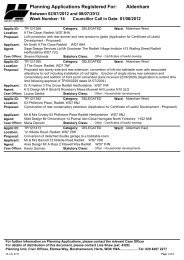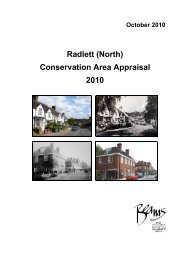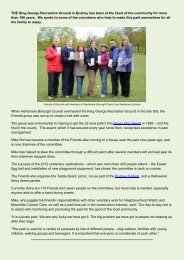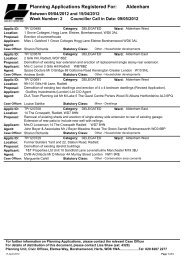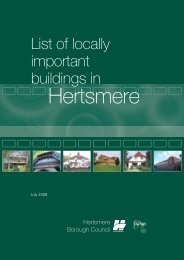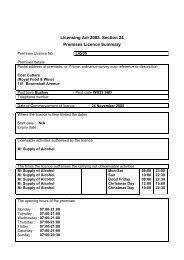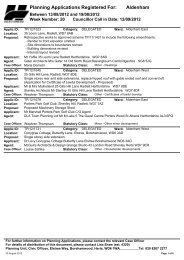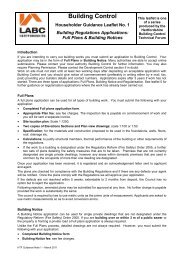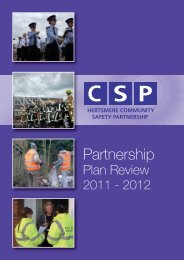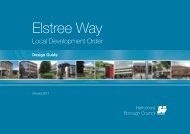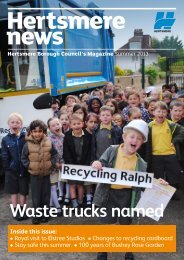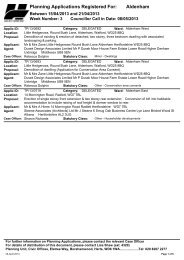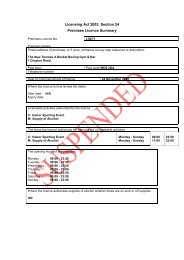Biodiversity - Hertsmere Borough Council
Biodiversity - Hertsmere Borough Council
Biodiversity - Hertsmere Borough Council
You also want an ePaper? Increase the reach of your titles
YUMPU automatically turns print PDFs into web optimized ePapers that Google loves.
Supplementary Planning Document - Part B: <strong>Biodiversity</strong><br />
5. Habitat resources in <strong>Hertsmere</strong><br />
5.1 Habitats resources are key to supporting and underpinning biodiversity within <strong>Hertsmere</strong> and it is the policy<br />
of <strong>Hertsmere</strong> <strong>Borough</strong> <strong>Council</strong> to endeavour to protect these habitats through the planning system where<br />
possible. Much of the information on habitat extent and distribution is derived from the County Habitat<br />
Survey, which was undertaken between 1994 and 1997. It provides the best available data source on<br />
habitat resources, although individual sites and areas may have been resurveyed since.<br />
Woodland<br />
5.2 Clearance of woodland has left <strong>Hertsmere</strong> with little of this habitat – about 754 ha or 7% of the borough,<br />
although the county average itself is only just over 9%. In turn, only 18% of this (135 ha) is considered to<br />
be ancient woodland (AW). Another 87 ha (11%) are considered to be ancient but are too small (less than<br />
2 ha) and do not occur on the AW inventory. However, what does survive is important, often occurring as<br />
quite large blocks. The most important of these is Redwell Wood near South Mimms. Other examples are<br />
Combe Wood at Shenley and Berrygrove near Aldenham although this has been substantially replanted<br />
with conifers. Most of the Ancient Semi-Natural Woodland is of the locally characteristic oak-hornbeam<br />
stand type with bluebell dominant in the ground flora. Approximately 85 ha – 0.8% of the borough – is<br />
parkland of varying ages, from medieval to modern.<br />
Management<br />
5.3 For ancient woodlands to flourish they must adopt three management approaches; there must be limited<br />
intervention in order to encourage natural processes, active conservation and sustainable commercial<br />
management either as high forest or coppice (BAP, 2006).<br />
5.4 Natural woodlands can be achieved through combining natural processes such as natural disasters<br />
(windthrow) that allow the cycling of nutrients, and mixed grazing regimes at low intensities. Grazing<br />
however must be controlled to ensure that they do not cause damage by inhibiting the regeneration of<br />
woody and herbaceous species but add to the natural functioning of the woodland. The use of mixed<br />
grazing causes problems such as the cost of fencing of the animals as well as the implications of limited<br />
public access.<br />
5.5 Combining woodland management with other habitat management will create an aesthetic natural<br />
change in habitats as well as corridors for wildlife.<br />
Restoration<br />
5.6 There is potential to restore semi-natural woodland sites back to natural woodlands as they potentially<br />
retain elements from former natural woodlands. There is also more scope for restoration of natural ancient<br />
woodlands where they are planted in close proximity to other ancient semi-natural woodlands. Keystone<br />
species from these semi-natural woodlands can help to colonise these new sites. Planting of trees should<br />
only utilise trees from locally derived seed stock (BAP, 2006). Economic incentives from the Forestry<br />
Commission may provide support for woodland restoration.<br />
Creation<br />
5.7 Due to lack of funding and incentives, there is limited financial support for new woodland planting in<br />
<strong>Hertsmere</strong>. The creation of new woodland will be supported if public access can be provided for or if there<br />
are economic prospects for landowners, through the production of good quality timber.<br />
5.8 In <strong>Hertsmere</strong> the Watling Chase Community Forest is linked to a strategy designed to increase the area of<br />
woodland in Hertfordshire. The plan is to increase the area of woodland within the forest area from 8% to<br />
30% by 2024.<br />
10<br />
5. Habitat resources in <strong>Hertsmere</strong>



